Uark Biopsychology Exam 2
1/70
Earn XP
Description and Tags
Josiah Leong
Name | Mastery | Learn | Test | Matching | Spaced |
|---|
No study sessions yet.
71 Terms
Observational research:
• Case study: study of an individual
- ex: lesion studies, ECoG studies
• Cross-sectional study: survey representative sample
- or survey the whole population = census
Experimental research:
• A study with a controlled manipulation in a random sample of the population.
• Quasi-experimental study: non-random sampling
(e.g., economics studies on demographic variables; socioeconomic status, geography, education
Types of data:
• Nominal
• Ordinal
• Interval
• Ratio
Nominal data
• labels / categories with no quantitative value
-different teams (ark v houston)
-different brain areas
Ordinal:
• rank / order with no quantitative value between ranks
• 1st, 2nd, 3rd place
-1st, 2nd, 3rd largest brain areas
Interval:
• numeric scale with measurable quantity between values, but no absolute zero
-time relative to first place
• functional MRI activity
• relative to average activity in task
Ratio:
• numeric scale with an absolute zero
-individual time trial
• 0 seconds is absolute 0
• number of times a neuron fired
• absolute 0 = 0 action potentials
Reliability:
• can I measure the same thing twice?
• e.g. the scale gives a consistent measurement
Validity:
• am I measuring what I think I’m measuring?
• e.g. the scale measures weight accurately
-Scale can be reliable but not valid
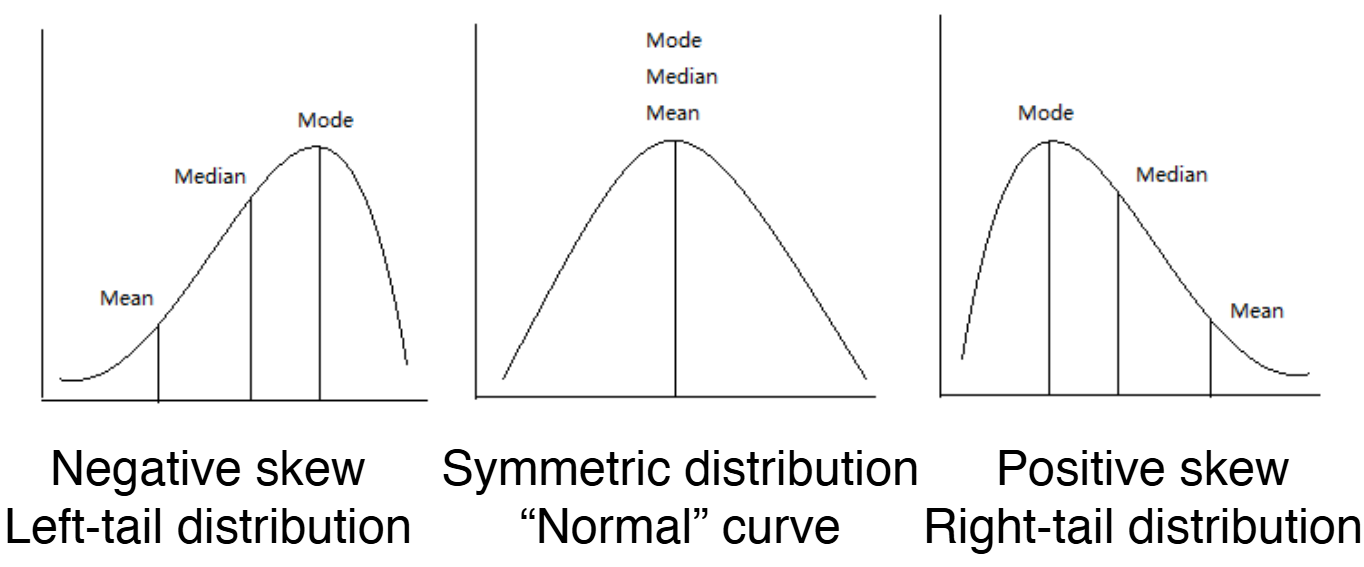
Central tendency:
• Mean = average value of the sample
• Median = value where 50% of the sample is higher and 50% is lower
• Mode = most common value
e.g. 1,1,4,3,7,6,4,3,6,2,1
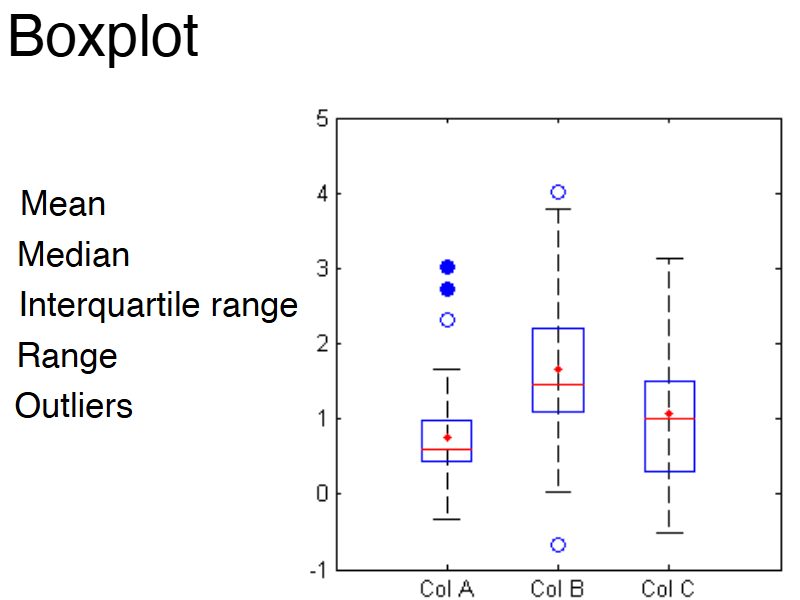
Measures of variability:
• Standard deviation = on average, how much do people differ from the mean?
• Range = minimum to maximum value
• Interquartile range = middle 50% of people (25th percentile to 75th percentile)
• Statistical outliers = people further than 1.5*IQR
(1.5 times IQR higher than 75th percentile or 1.5 times IQR lower than 25th percentile)
Visualizing your data
1. Comparisons: show differences between dependent variables
2. Causality: show how independent variable impacts dependent variable
3. Multivariate: make a complex narrative interpretable
4. Context: show before and after (include scale of measurement)
Testing your data
Inferential statistics
• t-test, analysis of variance, chi-square test
• correlation (and prediction)
t-test:
Is the difference between 2 distribution means meaningful?
The p-value tells us, assuming the null hypothesis is true, the
probability we would observe the difference in means.
Chi-square test:
Is the difference between 2 counts meaningful?
• Same as t-test, but testing difference in counts,
instead of continuous values
ANalysis Of Variance (ANOVA)
Same as t-test, but testing if the mean value is different between more than 2 conditions / groups
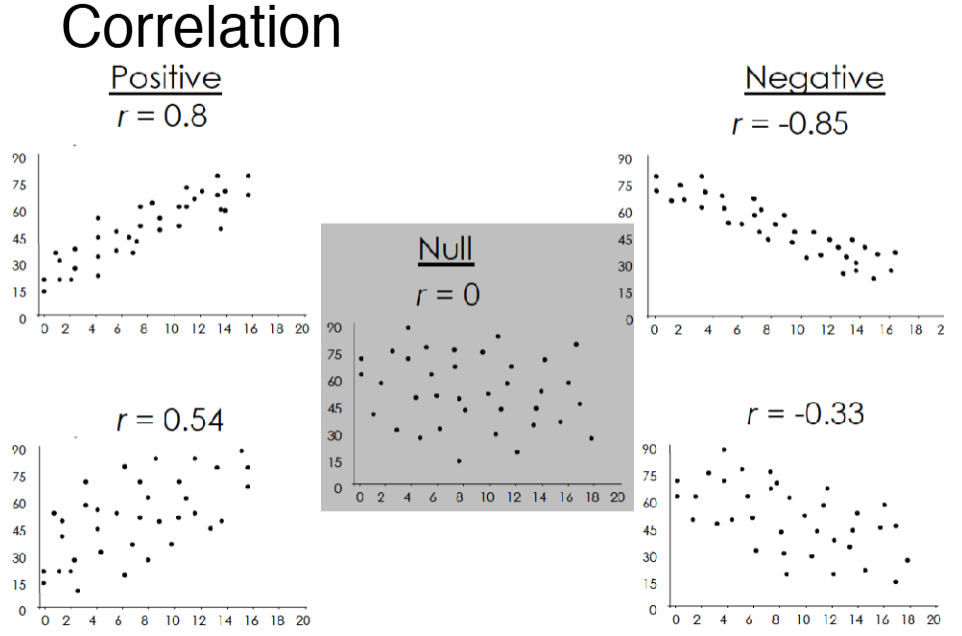
Correlation
Is the slope of the line different than zero?
Correlation does not mean causation
Confounds
• Lurking variable: a third variable (z) is creating the association
between your independent variable (x) and dependent variable (y).
• Unrepresentative sample: you did not randomly sample from the
population (i.e., just studied your friends, family, students)
• Failure to randomize: you accidentally put all Arkansans in one
experimental condition and all Texans in the other condition.
• Differential attrition: your subjects quit more in one experimental
condition than in another condition
• Placebo effect: your subject knows what you're looking for and
created the effect in their head.
• Observer-expectancy effect: you know what you're looking for and
biased your subject to do what you expect.
What is memory:
The record of experience in the mind that underlies meaning.
The '“knowledge” that guides behavior.
3 types: sensory, working, long term.
Sensory Memory:
Transient sensory records
-huge capacity, extremely brief duration
Working Memory
Thinking “ workbench”, must be rehearsed
limited capacity, flexible duration (RAM)
Long term Memory
unlimited capacity, potentially unlimited duration, different subsystems (Hard drive)
-implicit: procedural knowledge, conditioning, skills, etc.
-explicit: generic, episodic
elaboration
the addition of more detail concerning what is already in memory.
Illusion:
a misrepresentation or error in our
processing of sensory information.
• Illusions provide clues to how perceptual processes
construct our reality from sensory information.
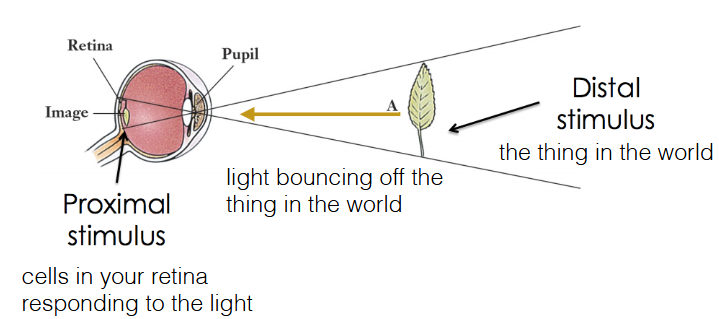
How do we perceive a 3D world from 2D input?
-the thing in the world
-light bouncing off the thing in the world
-cells in your retina responding to the light
Monocular depth cues
• Linear perspective: parallel lines seem to converge
• Texture gradients: groups of further objects appear
denser. distorts size of closer objects.
• Interposition (aka “occlusion”): overlapping objects
give impression of depth
• Shading: infer depth from shadows
Vision:
▪ Most sensory receptors (70%) of the
whole body are in your eyes.
▪ The eye’s retina has ~2 million cells
that respond to visible light and
transduce it to an electrical signal in
the brain
▪ Visual properties: size, shape, color,
brightness, distance, depth, motion
Eye structures
Pupil
Iris
Lens
Ciliary body
Suspensory ligaments
Fovea centralis
Retina
Optic disc
Optic nerve
Pupillary reflex
▪ Pupil changes size to
allow optimal amount
of light through
▪ Controlled by iris
▪ Pupil size is a useful
measure of arousal
(more later)
Lens accommodation
▪ Lens changes shape to
refract light to the optimal
place on the retina
▪ Controlled by ciliary body
& suspensory ligaments
▪ Myopia
(“near-sightedness”)
▪ Hyperopia
(“far-sightedness”)
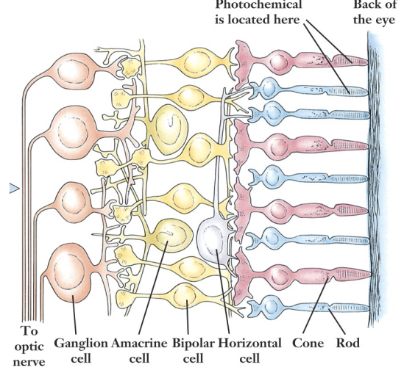
Retina
Visual transduction
▪ Photoreceptors
▪ Rods
▪ Cones
▪ Bipolar neurons
▪ Ganglion cells
2 types of photoreceptors
Rods
▪ gray scale vision
▪ peripheral vision
▪ vision under dim light (good tip for stargazing)
Cones
▪ color vision
▪ central vision (i.e., where you look directly;
technically called "focal point / foveation / fixation")
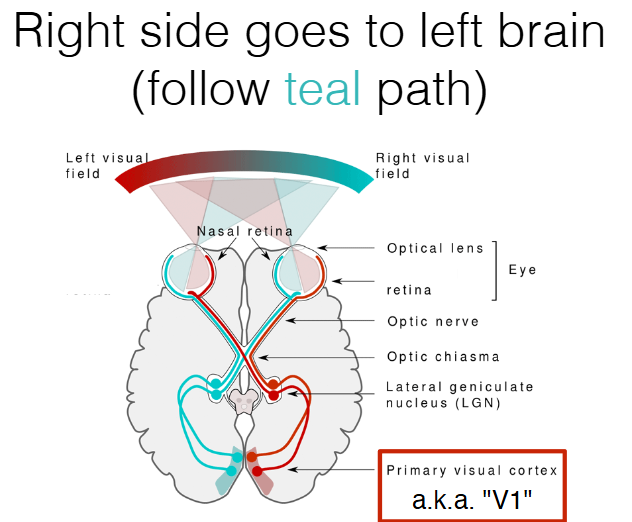
optic tract, visual field from which side goes where?
Left side goes to right brain
Right side goes to left brain
Input from each eye is
organized in
cortical columns
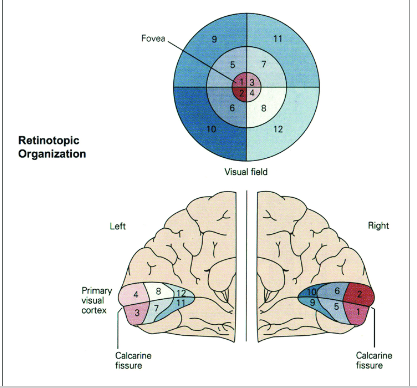
Retinotopic organization
• How the visual field is spatially organized in V1
• Left side goes to right brain, vice versa
• Top side goes to ventral / inferior / bottom, vice versa
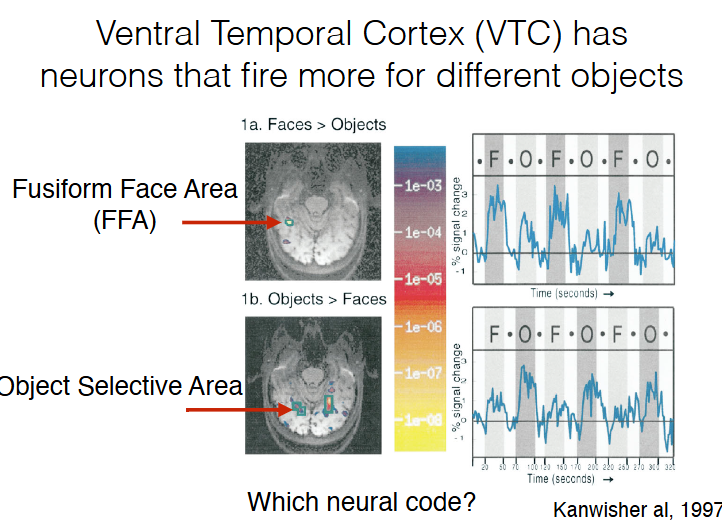
How do we recognize objects?
How about complex things like a face?
Ventral Temporal Cortex (VTC) has neurons that fire more for different objects
-Fusiform Face Area (FFA)
-Object Selective Area
Human hearing
The ear’s cochlea captures sound waves and transduces them into electrical signals for the brain
• Distal stimulus = the thing that
vibrates air molecules
• Proximal stimulus = cochlear
cells activating / firing
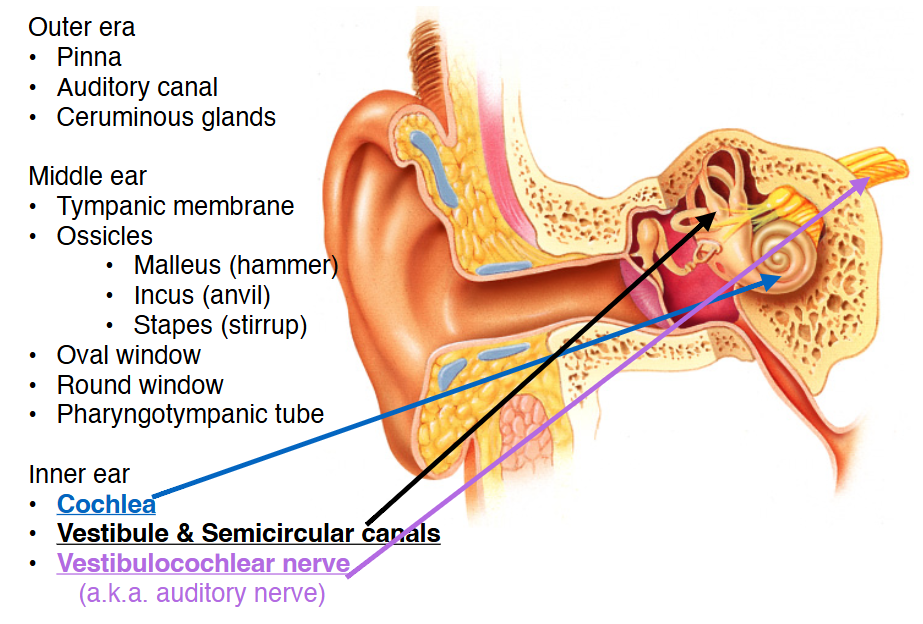
Inner Ear structures
• Cochlea
• Vestibule & Semicircular canals
• Vestibulocochlear nerve (a.k.a. auditory nerve)
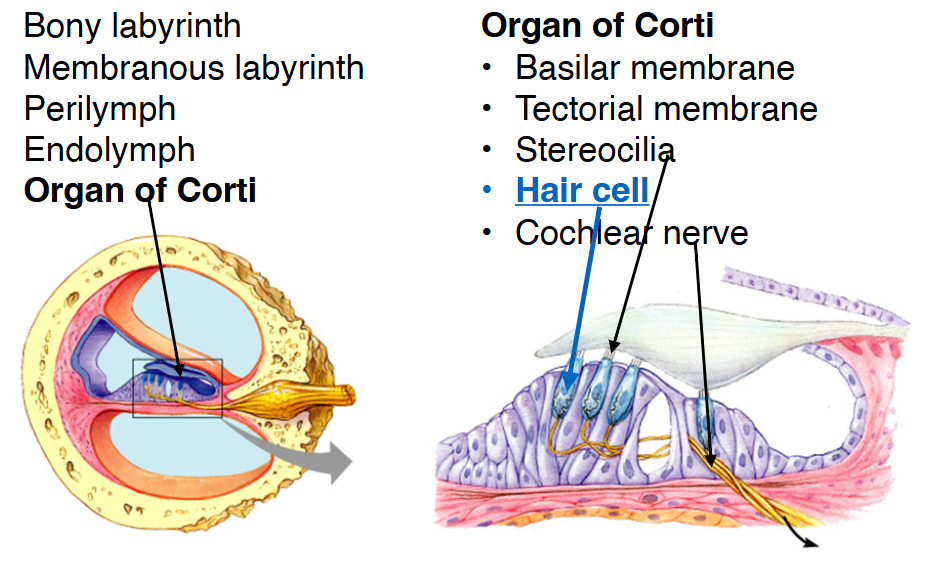
Cochlea structures:
Organ of Corti:
• Stereocilia
• Hair cell
• Cochlear nerve
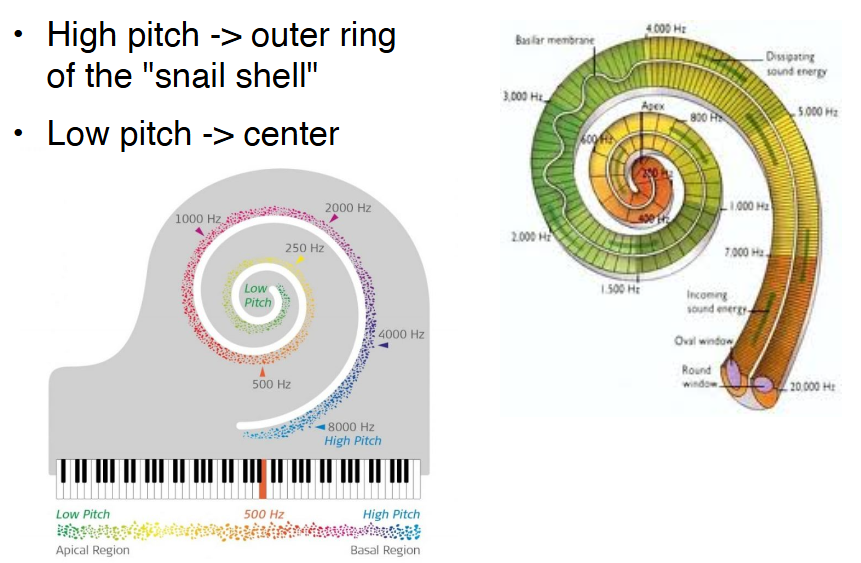
Tonotopy
• sound organized spatially
• Cochlea is organized spatially by sound frequency
• High pitch -> outer ring of the "snail shell"
• Low pitch -> center
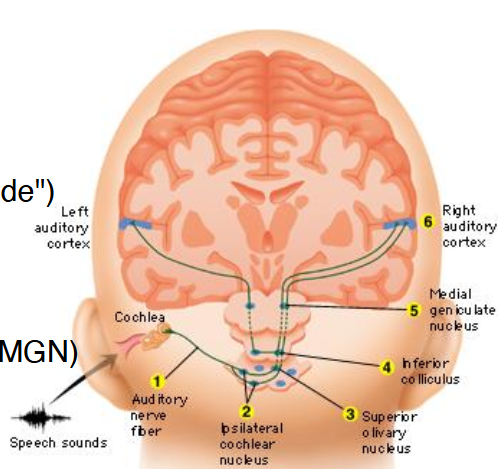
After cochlea -> Brain structures
(1) Brainstem nuclei
• cochlear nucleus (ipsilateral = "same side")
• superior olivary nucleus (contralateral = "opposite side")
• inferior colliculus
(2) Thalamus
• Medial Geniculate Nucleus (MGN)
(3) Primary auditory cortex (A1)
Note: Left ear goes to right brain; right ear goes to left brain
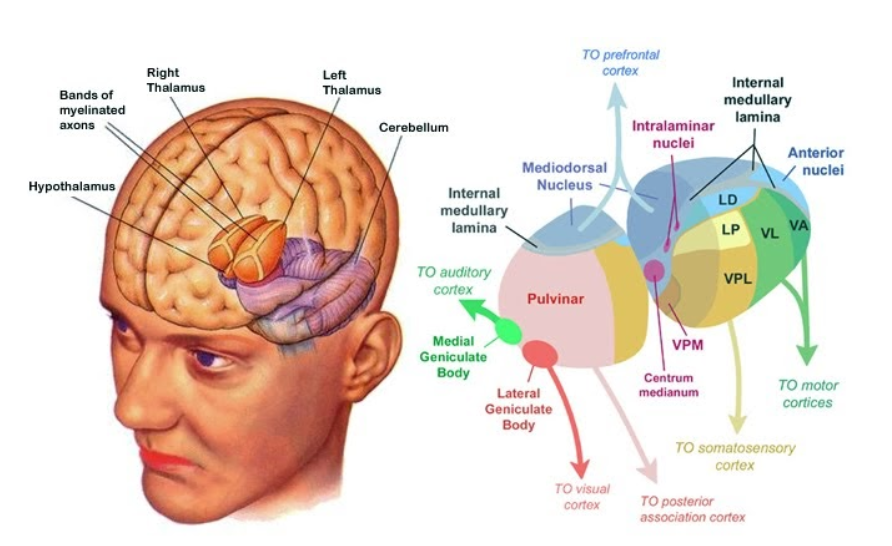
Thalamus
relay station
• Lateral Geniculate Nucleus (LGN): primary visual cortex (V1)
• Medial Geniculate Nucleus (MGN): primary auditory cortex (A1)
• Ventral Anterior/Lateral nucleus (VA/VL): primary motor cortex (M1)
• Ventral PosteroLateral/PosteroMedial nucleus (VPL/VPM): primary somatosensory cortex (S1)
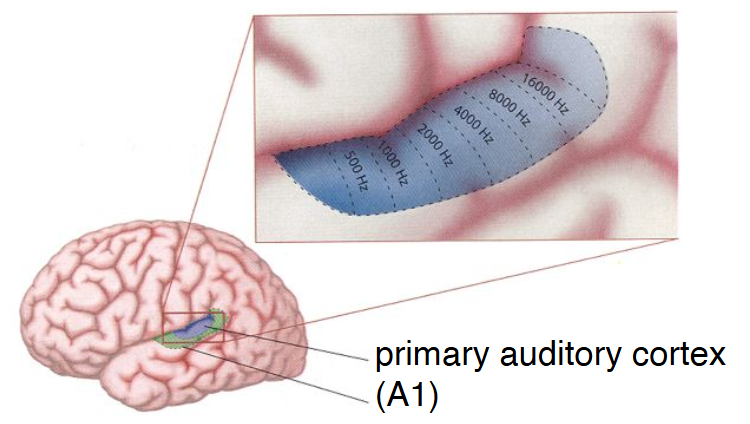
Primary auditory cortex (A1) has
tonotopic map: sound frequencies organized in different cortical columns
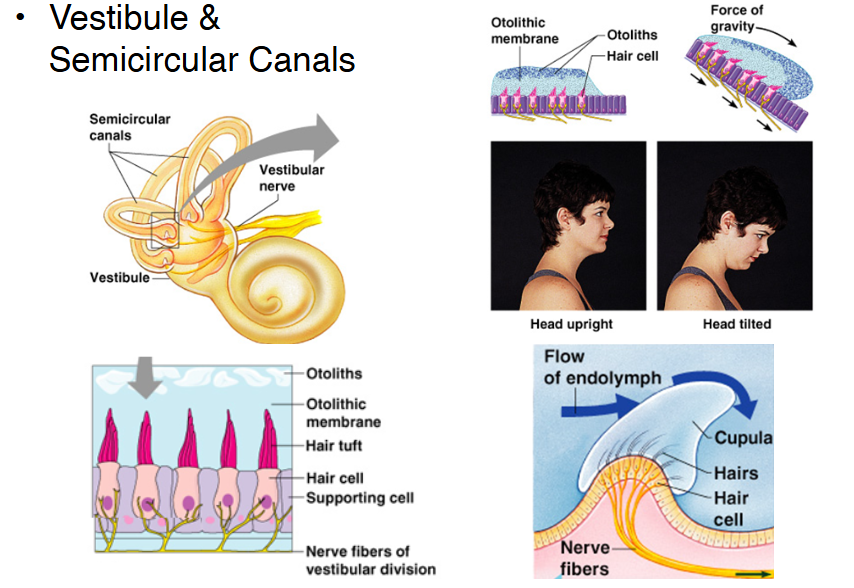
Equilibrium (sense of balance)
Vestibule & Semicircular Canals
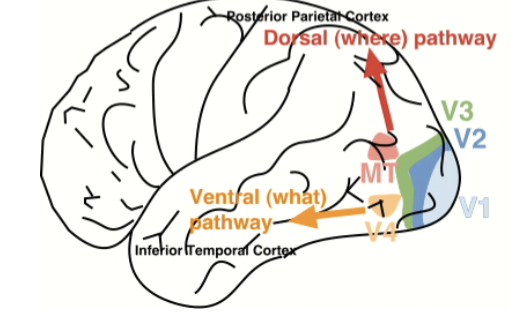
Location information flows where?
Topographic map in superior olivary nucleus
Send information to Posterior Parietal Cortex
(integrates with dorsal "where" pathway from vision)
Language
• Comprehension = "Wernicke's area"
-processes linguistic meaning (spoken, read, mimed)
• Production = "Broca's area"
-speak and write with proper grammar and syntax
- also "mirror neurons" to understand others' gestures
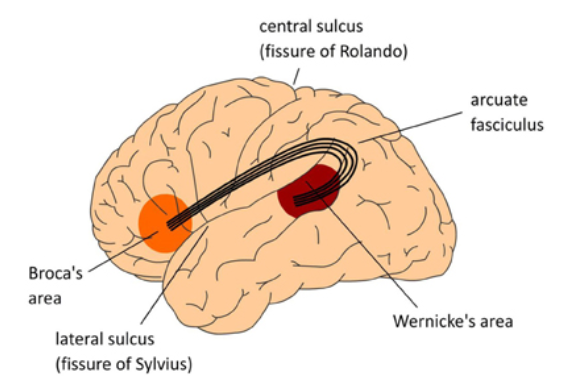
Arcuate fasciculus
• Wernicke's and Broca's areas are connected by a large
white-matter connection (a.k.a. "fasciculus" or "tract")
• allows sound, touch, and gesture to come together
Chemical senses
• Chemoreceptors stimulated by
chemicals in liquid or air
• Taste has five types of receptors
• Smell has huge number of receptors
• Taste and smell often work together
Human taste (gustation)
-taste buds capture chemicals and transduce them to electrical signals in brain.
• Includes five types of gustatory receptors and huge variety of tastants
• Based on ligand binding affinity (lock and key)
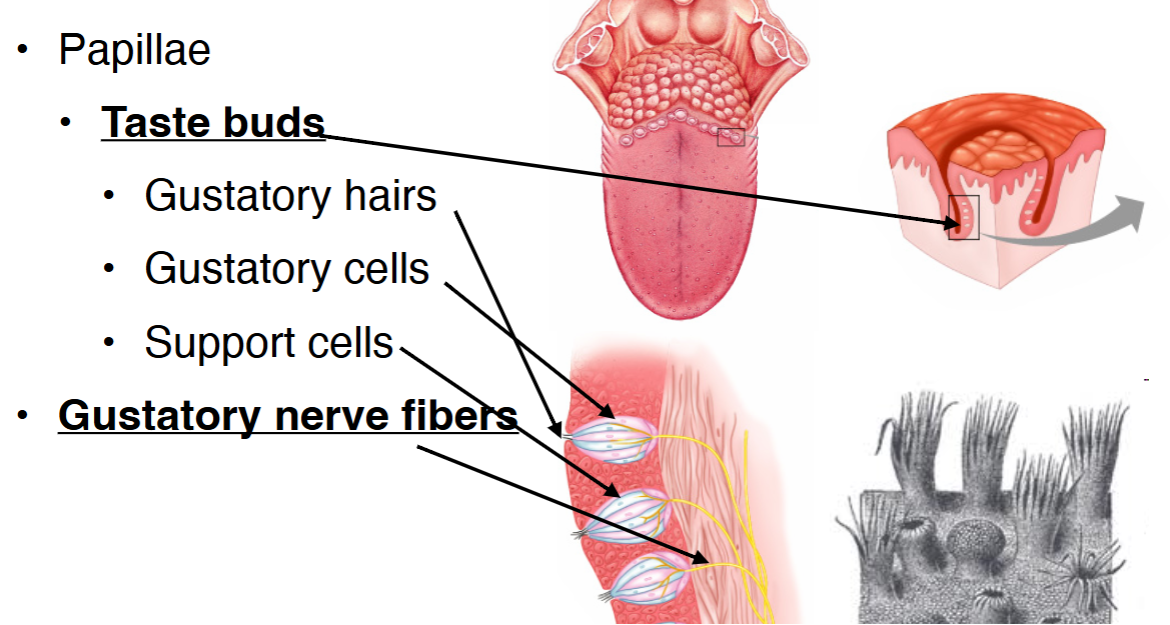
Mouth structures
• Taste buds
• Gustatory nerve fibers
Taste pathway
1) Oral cavity
2) Saliva
3) Taste buds
4) Gustatory nerve fiber
5) Brainstem (Gustatory nucleus)
6) Thalamus (Ventral PosteroMedial VPM)
7) Gustatory cortex (insula)
Human smell (olfaction)
The nose’s olfactory epithelium captures chemicals and transduces them to electrical signals in the brain.
• Includes a huge variety of odorants and olfactory receptors
• Based on ligand binding affinity (lock and key)
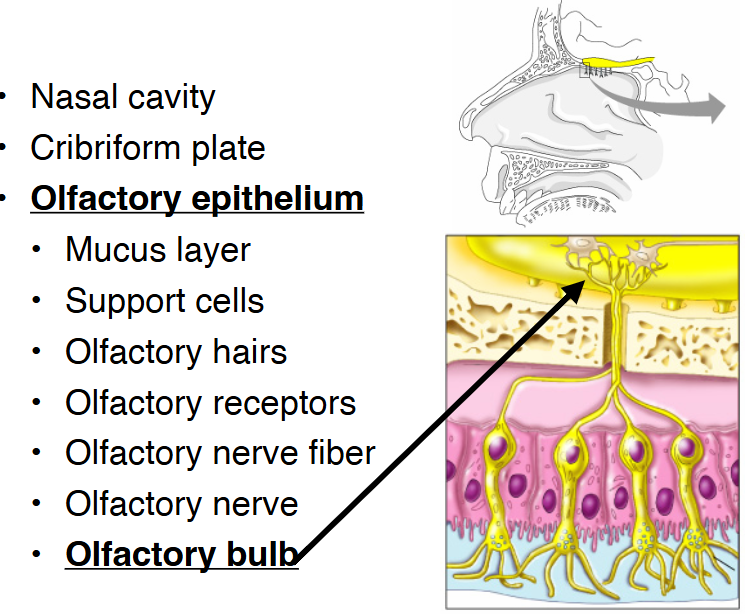
Nose structures
Olfactory epithelium
Olfactory hairs and bulb
Smell pathway
1) Nasal cavity (nose)
2) Olfactory epithelium
• Olfactory hairs & bulb
3) Brain regions
• orbitofrontal cortex (orbit means eye)
• amygdala and hippocampus
• both ipsilateral (same hemisphere)
Motion (how brain moves body)
• primary, premotor, and supplementary motor cortices
• link to language
• basal ganglia and cerebellum
• muscle contraction
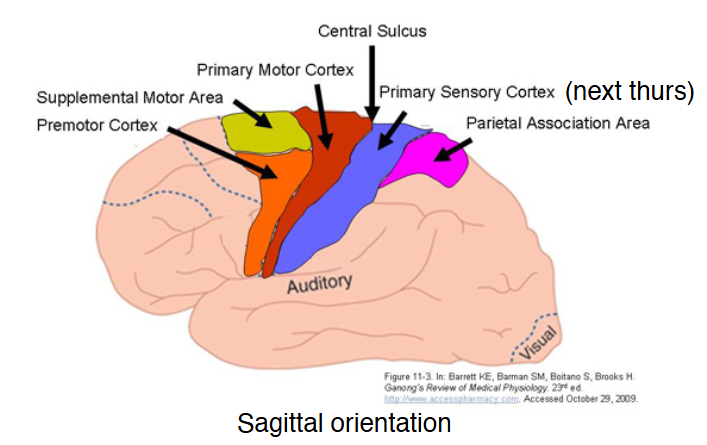
Motor cortices
primary, premotor, and supplementary motor cortices
primary sensory cortex, parietal association area
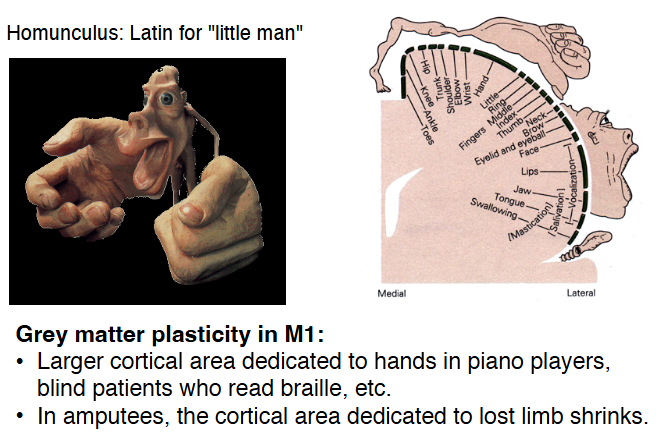
Primary Motor Cortex (M1)
Topographical organization: your body's muscle groups are organized spatially along primary motor cortex
-Body parts that need more control get more cortical real estate
Premotor cortex
Planning movements, selecting movements, Mirror neurons, links to language
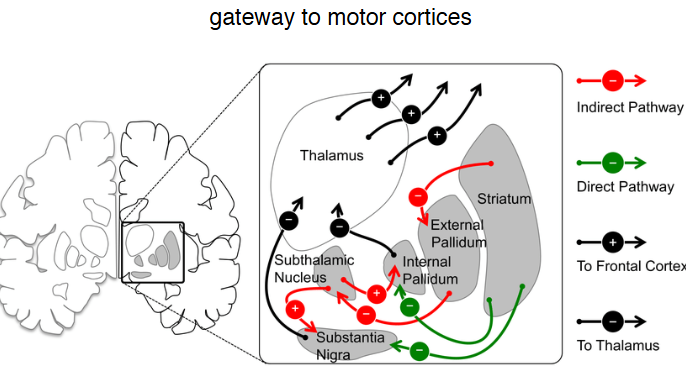
Basal ganglia
gateway to motor cortices. has two pathways
-Thalamus turns on primary motor cortex
(which makes muscles contract / relax)
Diseases affecting motor control
• Parkinson's disease
-substantia nigra neurons die
-> no dopamine production
-> less activation of direct pathway in basal ganglia
-> cannot initiate movement
• Huntington's disease
- autosomal dominant genetic mutation
-> kills neurons in basal ganglia
-> cannot coordinate movements
-> hyperkinetic (too much movement)
Cerebellum
fine motor control (has more neurons than rest of brain!)
-modifies signals from M1 before sending to muscles
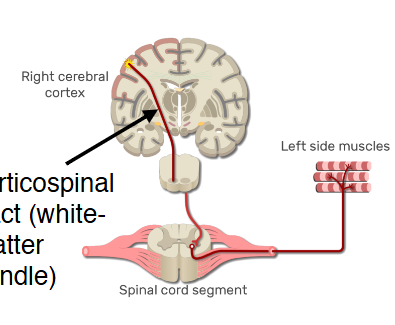
Spinal cord
corticospinal tract (white- matter bundle)
- contralateral control left hemisphere controls right side right hemisphere controls left side
Muscle Contraction
-know Acetylcholine is a neurotransmitter at Neuromuscular junctions.
• Muscle Tetanus = adding multiple contractions
Somatosensation "sense of your body"
-Proprioception: how do you know when and where you moved?
• Pain, temperature
Receptors under the skin, muscles, and viscera (organs)
• Mechanoreceptors: detect stretching, shrinking, shearing, pressure, weight
• Nociceptors: detect temperature, electricity, chemicals
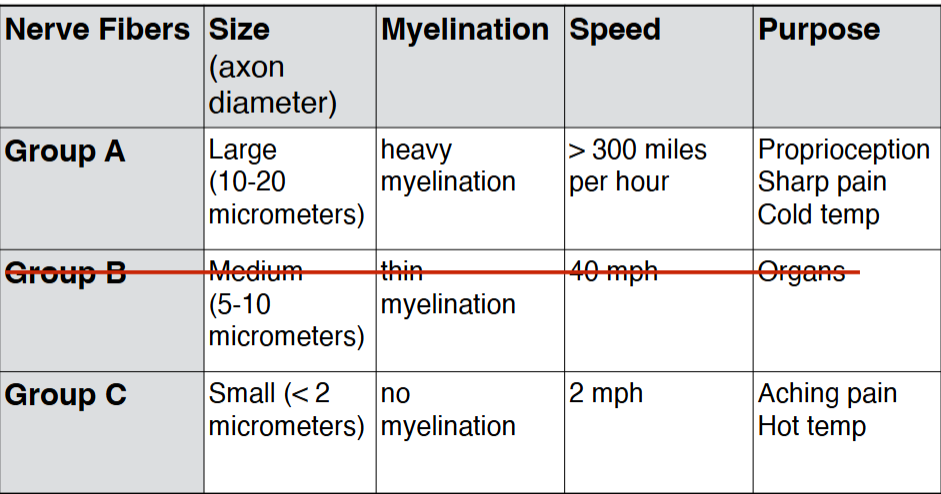
3 types of nerve fibers from skin, muscles, viscera, group:
Group A: Proprioception, Sharp pain, Cold temp
Group C: Aching pain, Hot temp
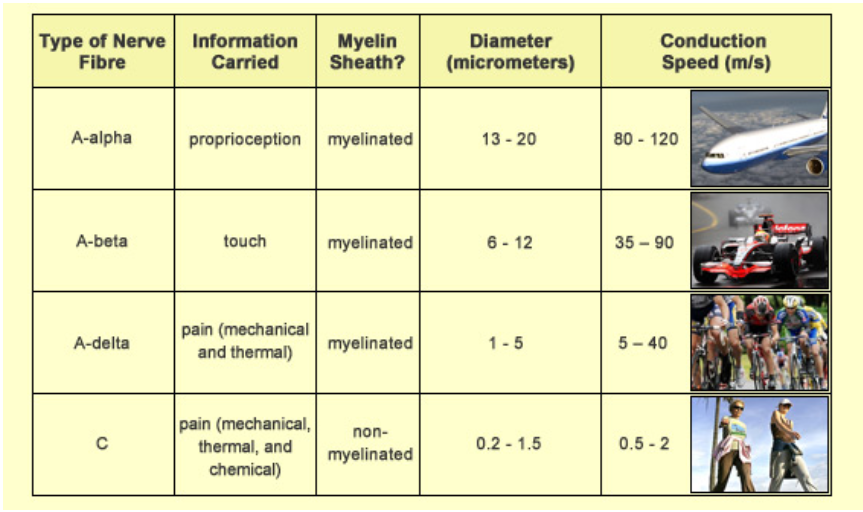
Group A and C fibers
• Group A-alpha: proprioception (super fast)
• Group A-beta: touch (super fast)
• GroupA-delta: sharp pain, cold temp (fast)
• Group C: muscle aches, toxic chemicals, hot temp (slow)
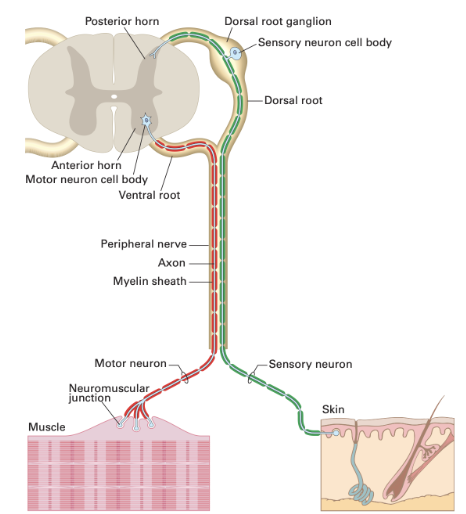
reflex arc:
sensory neuron turns on motor neuron
Topographical organization and homunculus
little man representing muscles / skin / organs splayed along primary somatosensory cortex (S1)
- rate code for when specific body part had mechano / nociceptive receptors activated
- more gray matter (neurons and cortical columns) for body parts for which you have finer sense
Combining senses
• primary visual (V1), auditory (A1), and somatosensory (S1) cortices send signals to the Posterior Parietal Cortex (PPC)
• stitches together where something is (visually and aurally) relative to our body
Pain in the brain
• Reducing pain: endogenous drugs (endorphins), or exogenous drugs ( decrease permeability of ion channels)
• Placebo pain: your expectation about pain can activate the same network of brain activity (sparse code)
• Social pain and sensing other people's pain